Speech The Growth of Asia and Some Implications for Australia

Philip Lowe
Assistant Governor (Economic)
Talk to Citi Australia Inaugural Australian Investment Conference
Sydney –
Good afternoon. It is a pleasure to be here today.
As you all know, the past 18 months have been extremely challenging. Late last year, extreme risk aversion swept the world. Global capital markets virtually shut down and confidence in many financial institutions was shaken to its core. Global industrial production collapsed, as did world trade. The result of all this has been the worst global recession since the early 1930s.
Yet, despite this incredibly difficult backdrop, the Australian economy has been surprisingly resilient. Amongst the main developed countries, Australia is the only one that has not recorded a negative year-ended growth rate during the global downturn. It is also the only one which has not recorded a drop in its export volumes.
There are a number of reasons for this relatively good performance, which I think are now pretty well understood. The timely and large adjustments to both monetary and fiscal policy have been important. So too has the healthy state of the banking system. The depreciation of the currency over the second half of last year was also a factor. And last, but not least, Australia's trade links with Asia, and in particular China, have been an important factor.
Rather than going over this ground again this afternoon, I would like to lift my gaze beyond the immediate outlook for the economy and interest rates to focus on a medium-term structural issue. While it is always a bit treacherous doing this, given the very large uncertainties involved, it is important to do so if we are to plan for the future.
My central theme is that there are reasonable grounds for optimism about the prospects for the Australian economy over the decade ahead. There are a number of reasons for this, but the one that I would like to discuss today is our growing trade links with Asia.
Over the past decade or so, there has been a significant shift in economic weight away from the advanced economies to those in the emerging world, especially those in Asia. This shift has recently picked up pace, with many of the advanced economies weighed down by the problems in their financial systems. And importantly for Australia, this shift has much further to run and is likely to have a profound effect on our medium-term prospects and the structure of our economy. In my time today, I would like to touch on some of these changes.
The Shift of Economic Weight to Asia
First, it is useful to begin with a few facts and figures.
If we go back to 1990, the countries of east Asia, excluding Japan, accounted for around 7 per cent of global GDP at market exchange rates. Just 20 years later, this figure has more than doubled to almost 15 per cent (Graph 1). Over these two decades, growth in east Asia has averaged 7 per cent a year, compared with just 2 per cent for the G7 group of countries. Growth has been strongest in China, with the level of Chinese real GDP increasing almost six-fold since 1990. India has also recorded strong growth, especially over recent years, with the level of Indian real GDP tripling since 1990. By comparison, European and US real GDP have increased by only around 50 per cent over the same period (Graph 2).
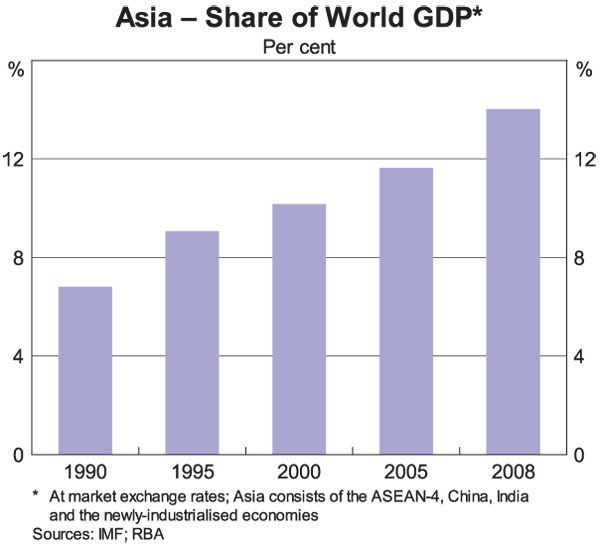
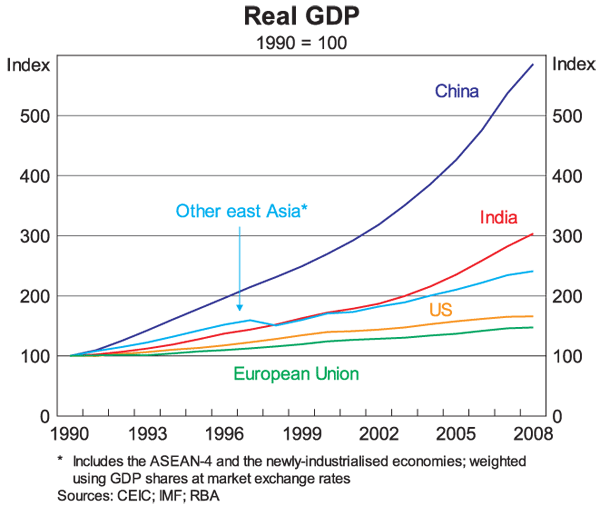
The figures for industrial production are starker still, particularly for China. In 1990, China accounted for just 2 per cent of global industrial production; today the figure is around 13 per cent. Industrial production has also expanded quickly in India, with growth averaging 8 per cent over recent years.
Another illustration of the change that is going on can be seen in the figures on car sales. Over recent months, the number of cars sold in China has been roughly equal to the number sold in the United States. In contrast, back in 1998, for every 100 cars sold in the United States, only 10 were sold in China. Similarly, Indian car sales have grown very strongly, trebling over the past eight years. Global steel production provides another example of the shift in the world economy, with China currently accounting for almost 50 per cent of the global output of steel compared with only around 15 per cent a decade ago (Graph 3).
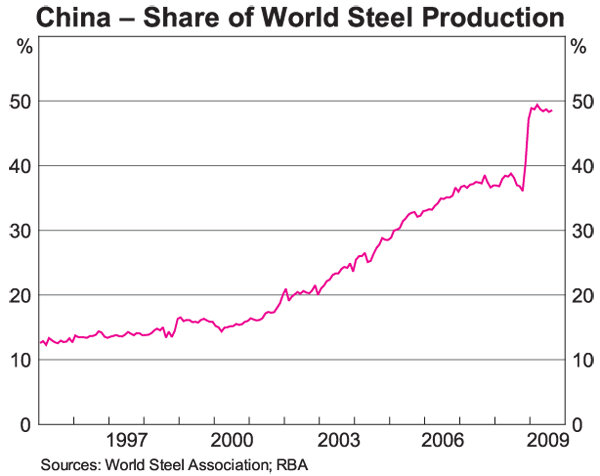
The general picture here is pretty clear: there has been very strong growth in Asia, with the economies of the region now accounting for a significant share of world output. And looking forward, there is a high probability that this will continue over the years ahead. As an illustration of the ongoing shift, recent growth projections from the IMF suggest that by 2014, the total amount of fixed asset investment in the developing world – much of which will occur in Asia – will be the same as that in the advanced economies (Graph 4). This would be a remarkable change from the situation just a decade ago when the level of investment in the developing world was only one third of that in the developed world. The change that is going on here reflects the subdued prospects for many of the advanced economies, the high pace of growth in Asia, and the current high rates of investment in many Asian countries.
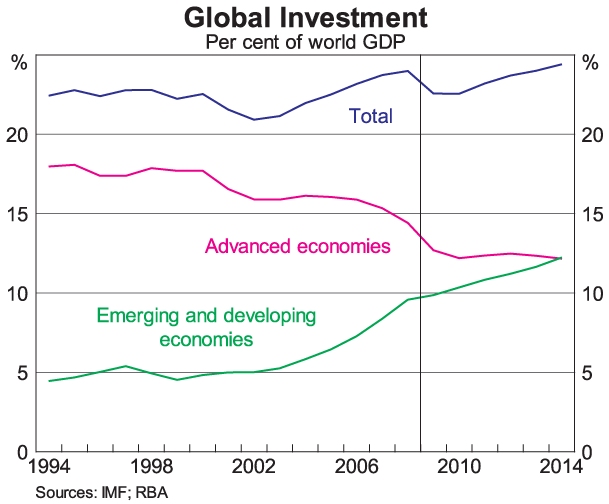
Again looking forward, a central question is whether Asia can continue to grow strongly over the coming years in the face of what seems likely to be weak external demand from the advanced economies.
The reasons for this weak demand are well understood. The household sectors in a number of the advanced economies face further balance-sheet adjustments. Difficulties in the financial sector are weighing on the availability and pricing of credit. And many governments will need to take significant steps to put their fiscal positions on a sounder footing. As an illustration of the challenge here, the ratio of aggregate net public-sector debt to GDP for the G7 countries is likely to exceed 90 per cent within a few years, an outcome that has not previously been seen outside of periods of war (Graph 5). This increase comes at a time when many governments already face significant medium-term fiscal challenges due to the ageing of their populations.
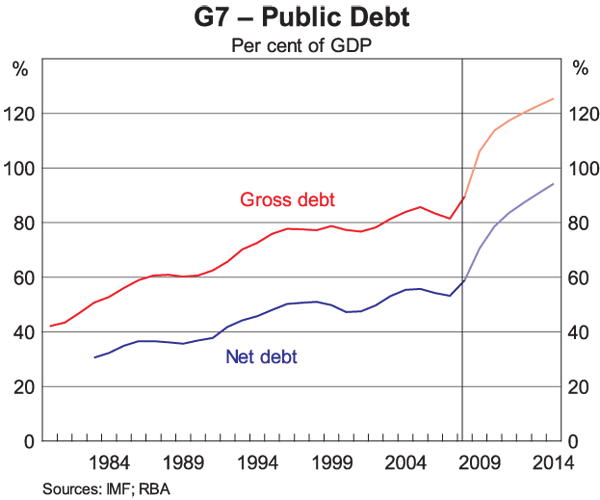
One school of thought is that if growth is indeed weak in the advanced economies, then growth in Asia will inevitably also be weak, particularly given the role that US and other western consumers are often credited with as a driver of growth in the region.
Undoubtedly, there is an element of truth here. Slower growth in the advanced economies will inevitably weigh on growth in Asia. The business cycles of the major regions of the world are clearly interconnected, and the ups and downs in one part of the world have an effect in other parts of the world.
But importantly this is not the end of the story. These interconnections do not mean that Asia must inevitably experience a marked reduction in its medium-term growth trajectory. As we have seen recently, the region has the capability to grow strongly through domestic, not external, demand. This really should not come as a surprise.
After all, the US economy, with a few hundred million people, has grown for many decades largely on the back of domestic, rather than foreign, demand. There is no reason that the approximately 3½ billion people in Asia cannot do the same. It ultimately comes down to the policy choices that are made.
Here, there is a reasonably broad consensus as to the types of policy steps that could be made over the medium term, although the specifics clearly differ from country to country. One possibility is continuing liberalisation of the services sector, which has the potential to grow strongly in many countries in the region. Another is reform of retirement incomes policies to give people more confidence that they will have sufficient income in their old age. A third possibility is further development of the financial sector so that savings can be most efficiently allocated to those who can make best use of them.
These are all rather long-term structural issues but gradual progress on these fronts can help form the basis for sustainable growth in domestic demand over the medium term in many of the countries of the region. There is also considerable scope for high levels of infrastructure investment in many of these countries, and the process of technology convergence has much further to run. And many of the countries of Asia are devoting increasing resources to education to improve the average productivity of their workforces.
Of course, none of this means that strong growth in Asia is assured, or that the process will be a smooth one. No doubt there will be bumps along the way and there will be periodic setbacks, perhaps of a significant scale. But over the medium term, there is a considerable basis for optimism about growth prospects for Asia, particularly as the economies re-orient towards domestic demand.
The Impact on Australia
I would now like to turn to some of the implications of all this for the Australian economy. In particular I would like to focus on four areas where we have already seen significant changes: the structure of our international trade; the prices at which we are able to sell our exports; the level of investment; and the rate of population growth.
Perhaps nowhere is the impact clearer than in the structure of our international trade, especially our exports. The recent trade data show that Australia's four most important merchandise export destinations this year have been China, Japan, South Korea and India – all in Asia (Graph 6). The fifth largest is the United States. Just six years ago the United States was ranked second, but it was first overtaken by China, then South Korea, and then just recently, by India. Collectively, these four large Asian trading partners have accounted for around 55 per cent of our total exports of goods over the past 12 months. Adding in the rest of Asia, the figure is around 70 per cent.
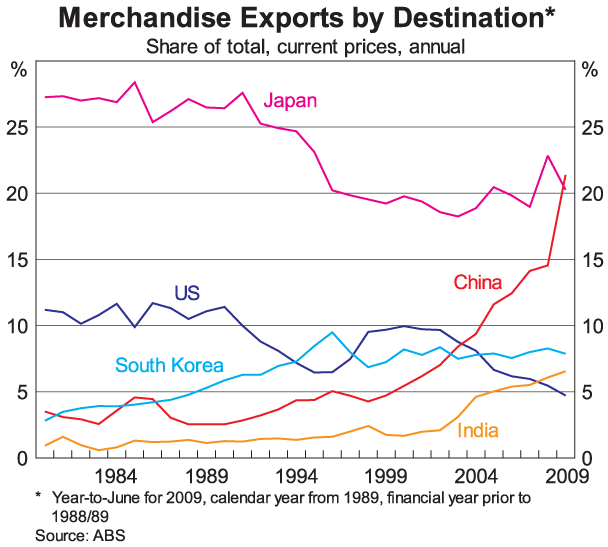
In the current global downturn, we have benefited from this re-orientation of our exports towards Asia. Despite global trade falling by nearly 20 per cent over the past year, the volume of Australian exports stayed broadly flat over this period. The strong recovery in China saw demand for raw materials rebound strongly, and Australian producers were able to respond quickly. A number of other commodity exporting countries whose major customers are in Europe and North America have, until very recently, had less favourable experiences.
There have also been very large changes in the structure of our imports. Back in 1990, around one third of our imports came from Asia. Today the figure is around one half.
A second area where the impact of the growth of Asia can clearly be seen is our terms of trade – that is, the prices we are paid for our exports relative to the prices we pay for our imports. Recently, there has been a deal of attention paid to the fact that commodity prices have fallen from their peaks of last year. However, we should not lose sight of the more important point: that is, Australia's terms of trade remain at a very high level (Graph 7). It's worth remembering that at the moment, the terms of trade are around 50 per cent above the average level over the 1980s and 1990s. In fact, apart from the past couple of years, the only other time that they have been as high as they are now was a very brief period in the 1950s when the Korean War led to a spike in wool prices.
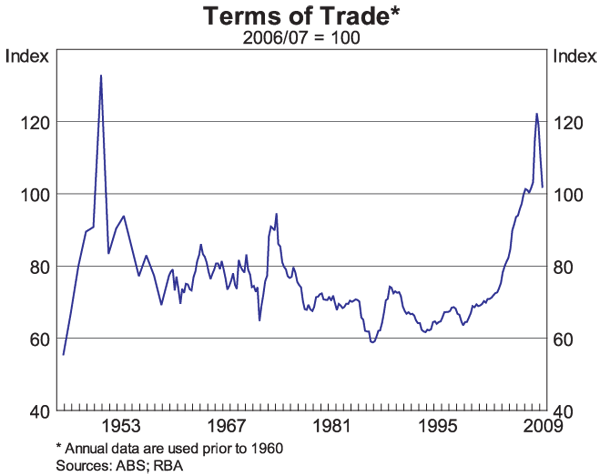
This strength in our terms of trade would certainly have come as a surprise to many of the commentators of earlier decades who thought that the prices of Australia's exports would inexorably decline relative to the prices of our imports. It has also come as a surprise to many contemporary observers. A year or so ago, if one had known that global industrial production would decline by around 15 per cent, and that the world economy would experience its most severe recession since the 1930s, few would have predicted that global commodity prices would hold up at current levels. There are no doubt a number of reasons for why this has occurred, but the strong recovery in Asia, and particularly China, must surely be near the top of the list.
The third area that I would like to touch on is investment. By the standards of the other advanced economies, Australia is a high investment country. Over the past year, private-sector business investment was the equivalent of 17 per cent of GDP, the highest on record (Graph 8). Total non-residential investment – including both private and public – has also been high. The result of this is that the capital stock in Australia is estimated to be increasing at around its fastest rate in several decades. Again, this is a strong outcome in the middle of a severe global downturn.
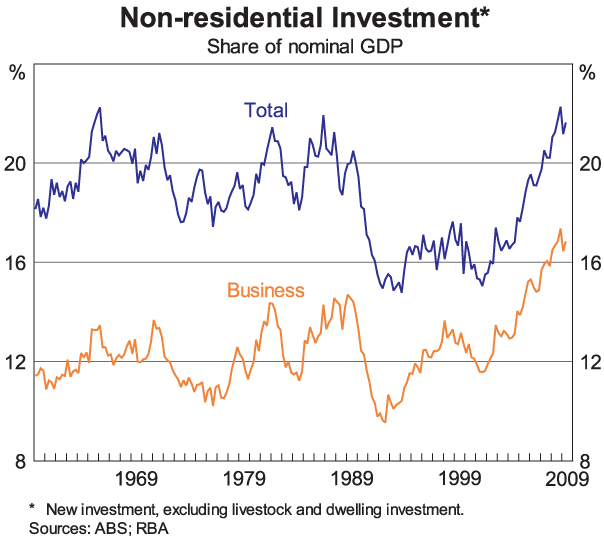
Not surprisingly, given the demand for commodities, this strength of investment is most notable in the resources sector. According to estimates based on ABS data, mining investment was the equivalent of almost 5 per cent of GDP over the past year, a record by a large margin (Graph 9). While we had booms in the mining sector in the late 1960s and the early 1980s, these look relatively small compared with the current one. Over the past couple of years, we have had particularly high rates of investment in both the iron ore and coal industries and this is now starting to show up in export volumes. For example, the volume of iron ore exports has risen by around a third over the past two years, as new mine and port capacity has come on stream, and further increases are likely.
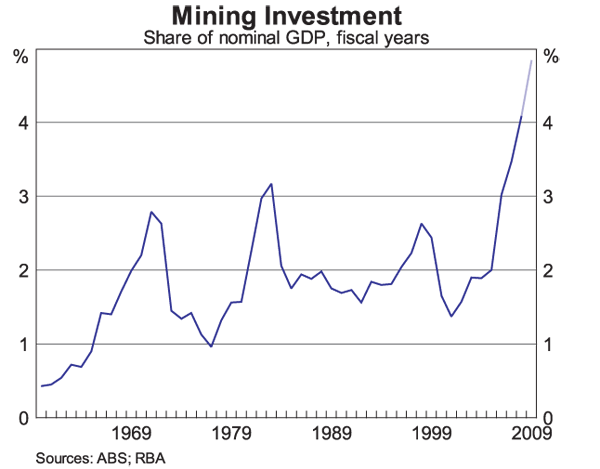
Looking forward, it is plausible that very high levels of investment in the resources sector will continue for some years yet. In particular, the outlook for LNG (liquefied natural gas) appears to be very positive, with a number of very large projects either underway or on the drawing board. There has already been significant discovery of gas reserves and the mining companies are signing long-term contracts with customers in Asia. Given the sheer magnitude of the projects, they are likely to have a significant impact on the future investment outcomes for the country.
Again, there are a number of reasons for this strong investment story. Political stability, sound macroeconomic management and microeconomic reform are all part of the equation. But so too are developments in Asia, with rapid growth in the region generating very strong demand for commodities. Australia is a reliable supplier of many of these commodities, and in some cases is a low-cost producer. We also benefit from our geographical proximity to the major markets of Asia. The end result is that both Australian and international firms have been prepared to devote significant sums of money to develop Australia's resources base, and it seems likely that they will continue to do so.
The final area that I would like to draw your attention to is population growth. Over the past year, the ABS estimates that the Australian population increased by 2.1 per cent (Graph 10). This is the fastest rate since the mid 1960s and three quarters of a percentage point faster than the average for the past twenty years. Again, this is in stark contrast to what is happening in almost all of the advanced economies where population growth has averaged around ½ per cent over recent years.
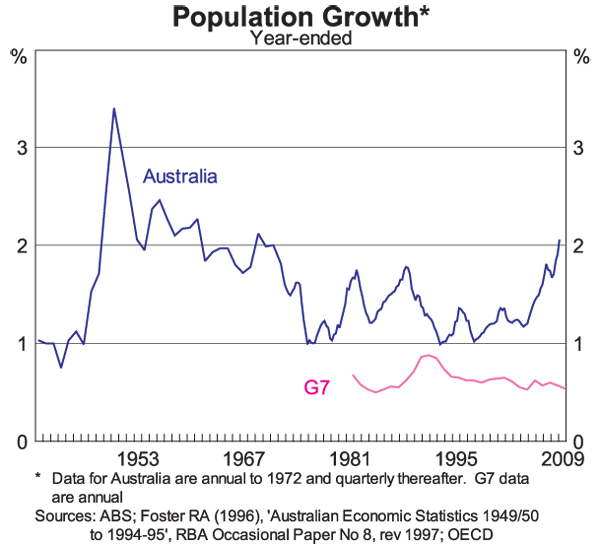
There are a variety of reasons for this pick-up in Australia's population growth, but I venture to suggest that it is not completely independent of the strong growth in Asia. With the Australian economy having performed comparatively well over recent years – partly because of developments in Asia – more workers have been needed to meet the growing demand for labour and to reduce bottlenecks in the economy. As a result there has been a substantial pick-up in immigration and this has boosted population growth.
So to summarise, over recent times we have seen a marked change in the structure of our international trade and a significant rise in the prices of our exports, as well as historically high levels of investment and population growth. In one way or another, each of these can be linked with what has been going on in the countries to our north.
As a result of these developments, Australia's medium-term economic prospects are more closely linked with those of Asia than has been the case ever before. Business cycle fluctuations in Asia are also likely to have a bigger effect on the dynamics of the Australian business cycle than has been the case in the past. Despite this, I suspect many of us still better understand what is going on in the 50 states of the United States of America than in the 30 plus provinces and administrative regions of China, or the 28 states and seven union territories of India. Over time, this will surely change. At the Reserve Bank I know how much more effort we are putting into understanding what is going on in the Asian region, and I am sure many of you in this room have moved in the same direction.
As we look beyond the challenges of the global recession, if one is optimistic about the medium-term prospects for growth in Asia, then there are reasonable grounds to be optimistic about medium-term prospects for the Australian economy. While there is still much uncertainty about how the world economy will evolve over coming years, Australia finds itself in a better position than most of the other advanced economies. This reflects not only our record of sound macroeconomic management and structural reforms, but also our considerable endowment of natural resources.
None of this, of course, means that success is assured, even if the countries to our north grow strongly over the years ahead. The policy choices we make clearly matter, and there are risks to be managed.
We need to ensure that our economy remains flexible so that labour and capital can move to where they are most useful. But as we make use of our comparative advantage, we also need to manage the risks that can come from increased exposure to movements in commodity prices and the relatively large cyclical fluctuations of some of the Asian economies. We need to keep the focus on removing impediments to capacity expansion so that the economy can grow without causing inflation. And we need to find ways of housing our rapidly growing population and dealing with the environmental issues that can come with growth.
These are all very real challenges that will continue to require hard work if they are to be met over the years ahead. But they are surely better challenges to face than those confronting most of the other advanced economies of the world.
Thank you for your time.